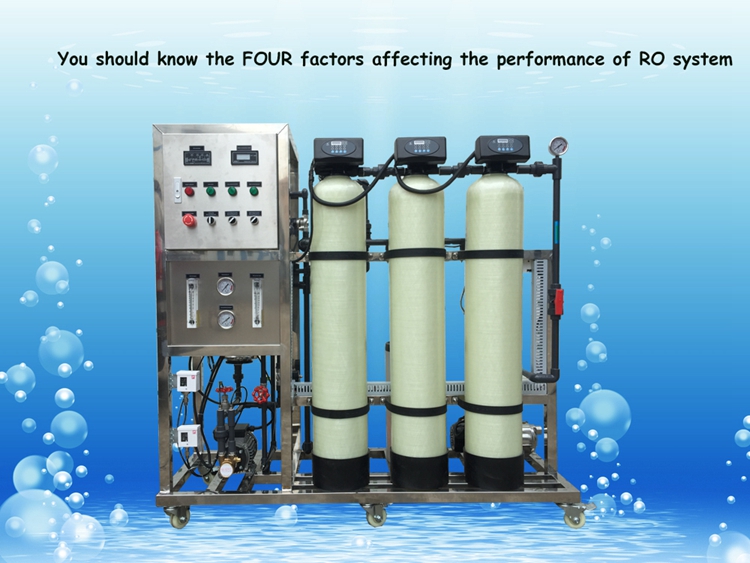In the application of water purification systems, we pay special attention to water production capacity and desalination rates, which are also key parameters of water purification systems. For example, when water purification systems is used to produce pure water in the winter, but the water capacity is less and the salt rejection rate is higher than before. We often think that the water production capacity and desalination rate that affect reverse osmosis which has the quality problems of the reverse osmosis system and often ignore the water factors. Raw water temperature, suspended solids, pH and inlet pressure will affect the water production capacity and desalination rate of the water purification systems. How do these factors affect the performance of the water purification systems?

1. Temperature: The reverse osmosis membrane water purification systems is very sensitive to changes in the influent water temperature. As the water temperature increases, the water production capacity also increases linearly. For every 1 °C increase in the inlet water temperature, the water production capacity increases by 2.5%-3.0% (standard at 25 °C). The reason is that the viscosity of water molecules passing through the RO membrane is lowered and the diffusion performance is enhanced. An increase in the influent temperature also leads to an increase in the salt permeability and a decrease in the salt rejection rate, mainly because the diffusion rate of the salt permeating through the RO membrane is accelerated by the increase in temperature. Therefore, as the water temperature rises, the amount of produced water increases almost linearly, besides the permeability of the salt also increases. Therefore, the higher the inlet water temperature, the greater the water production capacity, and the salt rejection rate will also decrease. Conversely, the lower of the water temperature, the smaller the water production capacity and the desalination rate will increase. This is the reason why the RO machine has reduced water production capacity and increased waste water volume in winter but the water quality is relatively high at this time (the salt rejection rate increases).
2. Suspended matter: The suspended solids have a great influence on the reverse osmosis membrane. The high suspended solid amount will cause severe clogging of the water purification systems which are affecting the water production capacity, water quality of the RO system and reducing the life of the reverse osmosis membrane. If the influent water is seriously polluted then it is generally recommended to add a precision filter and an ultrafiltration system after 3 level pretreatment system and finally install the RO machine.
3. pH: The pH of the influent water has two effects on the reverse osmosis membrane element. Firstly, the effect of the membrane system on the salt rejection rate during normal operation. Secondly, the effect of pH on the cleaning effect during the cleaning process. The influent pH has little effect on the water production flow rate and it has a great influence on the salt rejection rate. Since CO2 dissolved in water is present in the form of gaseous CO2 because of its low pH. It is easy to pass through the reverse osmosis membrane, so the desalination rate is low when the pH is low. With the increase of pH gaseous CO2 is converted into HCO3 ions which is more difficult to pass through the reverse osmosis membrane and the salt rejection rate also increases. The reverse osmosis membrane has the highest salt rejection rate between pH 7.5 and 8.5 where the salt rejection rate of the membrane system changes with pH. However, too high or too low pH may cause to damage the RO membrane.
4. Inlet water pressure: The influent pressure will affect the water production capacity and desalination rate of the RO membrane. Reverse osmosis technology overcomes natural osmotic pressure by applying operating pressure in the direction of the influent water flow. When the operating pressure applied to the concentrated solution is higher than the osmotic pressure, the flow direction of the natural permeation of the water molecules will be reversed and the concentrated solution will pass through the RO membrane to become purified water on the side of the diluted solution.
Therefore, the increase in the inlet pressure is linear with the increase in the water production capacity of the RO membrane. Since the RO membrane cannot completely retain the dissolved salts in the influent, the RO membrane increases with the pressure, and the water permeation rate is faster than the salt velocity. Therefore, the desalination rate is gradually increased on the other hand the water production flow rate is also gradually increased. However, there is an upper limit to increase the salt rejection rate of water by increasing the inlet water pressure. When a certain pressure value is reached, the salt rejection rate is no longer increases. In summary, as the influent pressure increases, the water capacity through the RO membrane will also increase and the desalination rate will increase to some extent. When a certain degree of salt rejection is reached, the salt rejection rate will not change.
A good understanding of the impact of these indicators on the performance of water purification systems allows us to minimize the adverse effects of these factors on reverse osmosis membranes which extend the life of the reverse osmosis membrane. Welcome to visit https://www.ocpuritech.com/ to learn more , it is a professional water treatment solution website.

